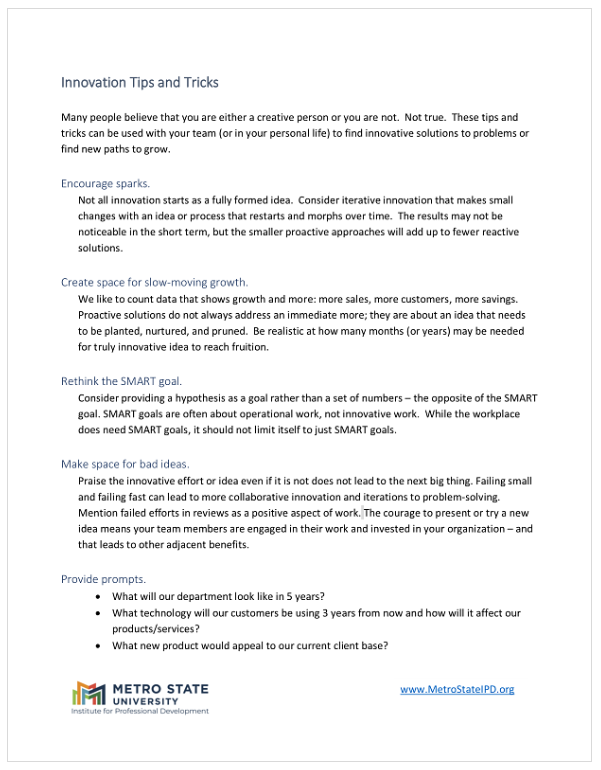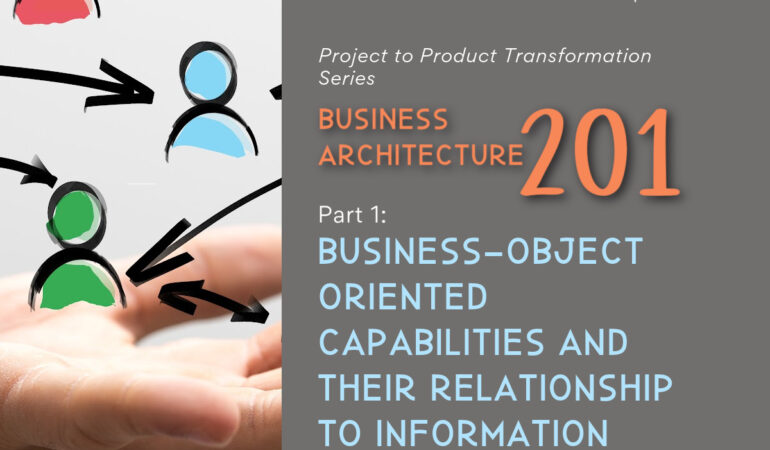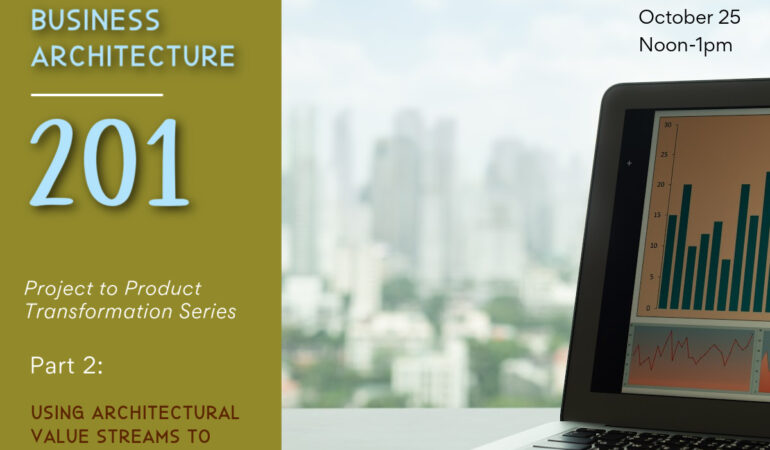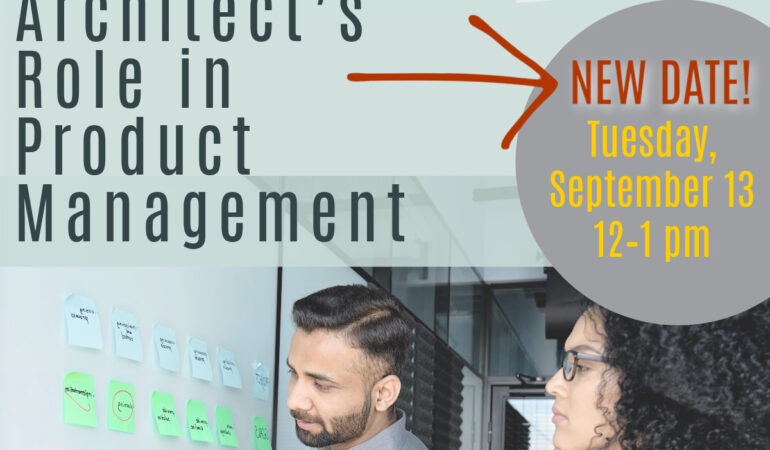Stop the World #2 | I Want to Be Innovative
Beth Schaefer IPD Director

In the first Stop the World article, I discussed making room for important work. Read Stop the World; I Want to Get Off Do Important Things to set the stage to engage or re-engage with your work and your coworkers. While that article discussed important work, some readers may have noted that it left out Innovation.
This month’s article focuses on making time to be innovative, which – because it’s so important – gets its own article. 60% of CEO’s rate innovation as important to the organization. Innovation is what allows an organization to flex, adapt, grow, and offer unique solutions to customers. Some might say innovate or disappear.
Take a look at your calendar for this week; how much time have you set aside to be innovative?
Innovation Culture Killers
In the first article, being physically (but not mentally) present and looking busy were called out as an enemy to productivity; they are also the enemy of innovation. The brain will not spend time on creativity when it is overworked or when pretending to do work.
Avoid these innovation culture killers:
1. Overloading people with operational tasks.
Those who lack time to complete their work are 3 times more likely to struggle with innovation. The trend to eliminate workers and “do more with less” continues. While I agree that a reduced workforce saves money in the short-term; in the long-term, the burnout will:
- Reduce workers’ ability to find process efficiencies
- Delay the development of new products or product improvements
- Negatively affect quality customer service (which research consistently tells us is closely correlated to how individuals feel about their jobs)
- Diminish the ability of workers to problem-solve
2. Encouraging only Quadrant 1 activities.
The first article in the series introduced The Covey quadrant model that categorizes workplace activity. Quadrant 1 activities are necessary and important, but having your head down, checking off task after task kills “aha moments”–those moments where you and your team discover a process improvement or a brilliant new way to suit customer needs. Constantly moving to the next thing does not allow the space for the brain to think creatively.
10 Strategies to Balance Necessity with Innovation
1. Improve processes so that mundane tasks don’t take so long!
Find out what rules and protocols are soaking up work time and fix them. “Process debt” can build up in small pieces without being noticed. Innovative people will be innovative if you remove the routines that prevent innovativeness. Ask your people. They will tell you which processes are overburdened and can be easily streamlined. Create an agile or flexible list and reorder each month based on current needs and new suggestions. Pick one cumbersome process each month and fix it.
2. Add innovation to performance goals.
Established goals are green lights that allow people to schedule innovation time. Host regularly scheduled “innovation sprints” every 2 weeks or once a month to help your team meet those goals. Consider inviting other departments to your sprint to create/revise a process you share.
3. Grant permission to turn off the world.
Encourage your team members to occasionally ignore the phone and turn on an Out of Office message to create blocks of time for activities that promote creativity. Set the example by blocking off time on your own calendar and pointing that out to your team.
4. Be Attuned.
Do not schedule or expect innovation during busy times. Most organizations have hectic periods where business is brisk or times when holidays or vacations are more frequent and fewer workers are in the office. Do not squeeze innovation into time when people are scrambling to serve customers.
5. Allow reading and viewing.
Reading leads to learning. Learning leads to innovation. Learning can also happen when viewing a Ted Talk or listening to a scientific podcast, or similar program. “I insist on a lot of time being spent, almost every day, to just sit and think. That is very uncommon in American business. I read and think.” -Warren Buffet.
6. Subtract something old before adding something new.
Innovation equals projects. Projects equal work. More work equals tough choices. Encouraging innovation may generate more ideas than can be simultaneously executed and sustained. If you continue to launch the new without removing the old, you have a recipe for overwhelming your team, and they will circle back to innovation stagnation.
7. Reward subtraction.
Addition is visible. Subtraction is invisible. Leidy Klotz addresses this in Subtract: The Untapped Science of Less where he calls this Shiny New Object Syndrome. Organizations tend to reward new things – additions – but they seldom recognize when someone is able to subtract an underperforming project or streamline steps to a process. Hold meetings focused on subtraction. Create a guideline to complete or subtract a priority or project before adding a new one. Openly celebrate subtractions; do not limit innovation to additions.
8. Make a path to submit new ideas.
If you ask your team how and when they submit innovative ideas, would they know? Provide many venues and modes for sharing. Let your team know that innovative ideas can be communicated through a sketch, a paragraph, a one-page document such as an SBAR, or a conversation. Make it easy to be innovative.
9. Teach innovation and creativity.
While some of your team members may just need time or permission to be more innovative, others will need specific tools, guidance, or established patterns for how to be innovative. See Innovation Tips and Tricks for more ideas on how to encourage innovation from your team.
10. Model
Ensure that your team sees you taking time to be innovative.
I know… All of this is easier said than done, so next month we will tackle, Stop the World, I Want to Get Off Find More Time
Stop the World Series Resource List
The 7 Habits
Encouraging Creative Thinking in the Workplace
Falling Behind on Work? Take These Steps to Get Back on Track
Finding Your Innovation Sweet Spot
The Hidden Tactic Overloaded Workers Are Using to Catch Up
How CEO’s Make Time to Create That Unexpected Lead Forward
How to Catch up on Work When You’ve Fallen Behind
How to Give Busy People the Time to Innovate
How to Gossip Strategically to Get Ahead at Work
Systematic Innovative Thinking
Top 10 Productivity Killers in the Workplace
Stop the World | I Want to Accomplish Something Important
Stop the World; I Want to Get Off Accomplish Something Important
Beth Schaefer IPD Director

Explaining Stop the World Logic
I had a conversation with a colleague last week who was lamenting the lack of time to complete all their work. This led me to think about time management and a phrase I often use in both my work and personal life, Stop the world; I want to catch up. I need everyone else to freeze in time so that I have a few days to keep working and get caught up.
And, as often happens, real life generates an article idea. In this case: time management. Yes, this is an old topic, but a perennial favorite because so many of us still feel the time crunch. Add it to the list of other topics we can never seem to get consistently right: change management, process improvement, onboarding, (add your own topic here). These are topics that we are constantly revisiting and learning more about because the gap between doing it, and doing it well, is so large.
Researching innovative time management ideas turned this one article into the Stop the World collection of articles. Because, as research tells me, time management is about more than just catching up.
What Am I Doing All Day?
Thinking about time management reminded me of Covey’s 7 Habits for Highly Effective People. I most recently used Covey in teaching a college course on effective supervision. Covey divides your time into four quadrants based on importance and urgency.
- Necessity: Important and Urgent
- Effectiveness: Important and Not Urgent
- Distraction: Not Important and Urgent
- Waste: Not Important and Not Urgent
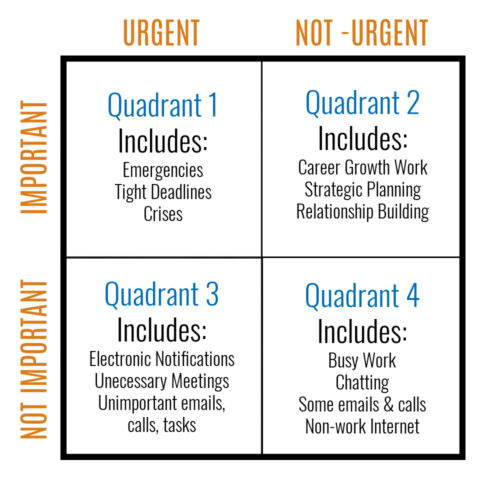
The Stop the World collection will focus on reducing Distraction and Waste so that you have more time for the Necessary and Effective. This may seem an obvious solution; however, the latest workplace trend is “Present-ness.”
Looking Busy
While “being present” is a good thing; present-ness is about appearing busy. Present-ness is the response to the return-to-office movement. Recent research has shown that people sitting at their desks in their offices are more likely to be seen as a quality worker, a dedicated worker, an engaged worker and are, therefore, more likely to receive promotions. However, that same research reveals that the traditional thinking of “desk = productivity” is not accurate.
Sitting at a desk in the office does not mean those workers are more productive. When it comes to perception vs. reality, perception is 9/10th of the law, so workers are willing to sacrifice productivity in favor of appearing busy. What are those “busy” people actually doing?
- Answering emails (average of 9 hours a week)
- Sitting in meetings (average of 7.5 hours a week)
- Gossiping (average of 2-12 hours a week depending on your source)
- Texting friends and family (average of 5 hours per week)
- Surfing the internet/social media (average of 5 hours per week)
“Busy” is, not necessarily, productive. “Busy” can happen at the office (gossiping even more so) just as easily as at home.
Accomplishing Something Important
With that new trend in mind, let’s take a look at the Effectiveness Quadrant. The Effectiveness Quadrant (Important, Not Urgent) includes proactive activities that can be done in an office located at work or at home:
- Setting important goals
- Planning
- Relationship Building
- Learning
- Thinking Creatively
Just thinking about doing these things at work makes me feel guilty because I am not crossing tasks off my to-do list; however, what strikes me about this list is that it correlates quite strongly to items leaders should do to promote employee engagement. (See our Employee Engagement series.) I firmly believe in cultivating intentional employee engagement. Maybe that will help me make time for important, not urgent items.
I also read this list and find that these items could fuel my own work engagement. I can proactively incorporate important, not urgent items into my own schedule to keep myself invested and model the importance of that quadrant to my team. You can too. What parts of your job do you love but do not take time to do because it feels like a guilty pleasure? Do them. If you do not have anything you like about your job, consider referencing the articles on The Great Resignation to find a new job.
For me, I love writing curriculum. It is no longer the main part of my role, but finding pockets of projects that allow me to write curriculum sparks creativity, keeps me engaged in my work, and gives me joy. For you, these activities could be taking some training, having a conversation with a mentor, or researching a topic you are passionate about. Clearly finding joy in your work can only be a good thing for both you and your employer.
Hopefully, the Stop the World collection of articles will help you to step off the busy-ness and step into what is important.
Next article in the collection coming next month: Stop the World; I Want to Get Off Be Innovative.
Stop the World Series Resource List
The 7 Habits
Encouraging Creative Thinking in the Workplace
Falling Behind on Work? Take These Steps to Get Back on Track
Finding Your Innovation Sweet Spot
The Hidden Tactic Overloaded Workers Are Using to Catch Up
How CEO’s Make Time to Create That Unexpected Lead Forward
How to Catch up on Work When You’ve Fallen Behind
How to Give Busy People the Time to Innovate
How to Gossip Strategically to Get Ahead at Work
Systematic Innovative Thinking
Top 10 Productivity Killers in the Workplace
Politics in the Office: Part 3

Top 10 List for Leaders
By Beth Schaefer
IPD Director
Despite your best efforts for a creating a respectful workplace for civil discourse (See Part 1 and Part 2 of Politics in the Office), the day after the election, there will be winners and losers. Do not assume everyone on your team will share your own response to the election results.
And…as the first 2 parts discussed, it is not just about red and blue, but about policies that will affect people’s families, economic status, religious beliefs, and healthcare. Regardless of who wins, the people on your team will face an unknown future. And, the unknown can bring fear, and fear can bring stress.
Consider these 10 strategies to assist your team through the most-intense weeks before and after the election:
- Accept a decrease in productivity. Just like the December holidays or a warm sunny summer afternoon in Minnesota, the pace of work will slow down. Plan for it rather than fight it.
- Plan your schedule and deadlines. If you know that your team will be especially distracted during the weeks before and after the election, avoid creating deadlines for your most critical projects or project pieces during that time.
- Focus on work. While productivity may decrease, you are still in the workplace. You can direct people to focus on work rather than half-day discussions at the water cooler. Consider tasks that are easy to complete. Perhaps that will be a good week to do some “housekeeping” work (updating files, cleaning emails) that improves productivity overall but is easy to do.
- Model respectful discourse. If you set political discussion boundaries, remind your team that they are still in effect after the election too. If you did not set boundaries, consider doing so. Be ready to respectfully end political discussions that are too long or are disrespectful.
- Be consistent. Treat all your team members the same even if their politics are different than yours. Make sure the guidelines you put in place are evenly enforced. If someone’s political discourse is disrespectful or harassing, as the leader, you need to address it. See Part 2 for strategies. When your team sees that you are serious about a safe space at work, it can reduce their stress.
- Schedule check-ins. If you do not currently do 1:1 check-in with your team members, this may be a good time to start. Use check-in time to see if they are feeling extra stress in general. You can do this without asking about political preferences. If they are having trouble focusing, suggest work that needs to be completed, but is not too challenging. This is also a good time to address any political talk that is not following the guidelines.
- Listen with empathy and seek to understand. Even if your politics are different, you can still listen to why people are disheartened by the results and provide empathy. See the article Heard! for a review of empathetic listening strategies.
- Suggest a media break. If the elections seem to be stressing out members of your team, suggest they step away from media and social media for a few days. Research is clear that social media can compound stress.
- Be ready with resources. Have your organization’s Employee Assistance Program links at the ready. Share them with individuals as needed or proactively share them with your team.
- Care. While this article is framed through the lens of workplace productivity, genuinely caring about your individual team members is one of the best ways to help them avoid burnout– whether it is due to the election or any other endless factors that contribute to life and work stressors.
Follow Up Note: In the Part 2 article, I failed the beginning assessment for leaders. I am happy to report that since I wrote that article, my organization provided training to staff and leaders on what types of political activity are acceptable in our workplace. The session was informative and clarified several guidelines for me. Since I work in education, our workplace guidelines are probably a bit trickier than most, and that made the training all the more helpful.
Resource List
7 Ways Employers Can Help Combat Election Anxiety in Their Workforce
How HR Can Guide a Workplace Through the Fraught 2024 Election Season
Navigating Pre- and Post- Elections Tensions in the Workplace
Polarizing Politics: How Leaders Can Protect and Support Psychological Safety in the Workplace
Rethinking Your Personal Workplace Brand – Free Training | October 2024 Expert Insights Webinar
Rethinking Your Personal Workplace Brand
Date and Time: Thursday, October 24, 2024, 12-1pm
Last Day to Register: Wednesday, October 23

- provide some considerations for personal branding strategies
- teach you to leverage your personal brand for leadership opportunities and workplace promotions
- guide you through some self-reflective activities to help you think strategically about your personal brand profile.
Registration is Now Closed

Politics in the Office: Part 2

By Beth Schaefer
IPD Director
Quick Quiz
- Does your workplace have a policy about discussing politics in the workplace?
- Does your workplace have policies on political ads in your office window, on your desk, on a button for your lapel or a T-shirt you wear?
- Do you know what those polices allow and prohibit?
- Do you know how to enforce it as a leader or how to diplomatically inform a coworker?
Here are the answers that I had before I did the research for this article:
- Maybe
- Maybe
- No
- No
Yes, it’s a Problem.
In Politics in the Office: Part 1, I wrote about my personal uncomfortable experience with political discussions in the workplace; however, research shows that I am not alone.
- 60% of American workers find political discussions in the workplace UNACCEPTABLE, yet 50% of us admit to engaging in them.
- 42% of American workers report that “political disagreements” with coworkers affect their work production.
Yes, it’s more of a problem now than in the past.
Elections are not new, but our political discourse has evolved along with our workplace behaviors.
- Lines between work and personal life have blurred – driven by remote workers, but also by the American workplace becoming more flexible with families (like many other countries). In the past, your coworkers’ personal lives and political views may not have been integrated into workplace discussions.
- Political discourse has become more divisive. Many political leaders themselves model rudeness and cancel culture instead of conversation and collaboration. Where you maybe once just disagreed with someone’s vote, now you feel pressure to be suspicious of their character for a differing political view.
- Federal policies have a larger impact on our family lives from the taxes we pay, to the cars, appliances, and windows we purchase, to the healthcare we can receive, to our families immigrating and joining us. Almost 50% of Americans fear changes brought by political elections – regardless of which side wins. This fear makes it difficult to ignore the sidebar of the national election going on outside work.
- In addition, the stress and fear of the election can affect workers’ mental health – which in turn affects your team.
All of these add up to politics being more intrusive to work production now than in the past.
You have options as coworkers and leaders.
Both coworkers and leaders should resist using politics as a reason to demonize people. This affects workplace relationships and contributes to a disrespectful culture that almost all workers agree they do not want as part of their workplace.
Here are some things you can do or say over the next two months to navigate politics in the office:
As a Coworker
Be aware of others.
- You may enjoy a good political debate, but others may find your conversations draining and time-consuming, so much so that their work performance can suffer, adding stress they do not need.
- Look at body language and listen to coworker statements to gage who may be interested in a political discussion at the water cooler or lunch room, and those who are not.
- Do not assume your coworkers have the same political views that you do, putting them in the uncomfortable place of debating you or dodging you (see Part 1).
- If you are passionate about a topic, consider constructive ways to share your political views and influence policy outside your workday.
-
Be aware of yourself.
- Know your own specific triggers to help you regulate your emotions at work. For instance, if you have a family member affected by immigration policy, have a statement ready, such as, “This topic frustrates me. While I know there are two or more sides to every issue, I have family directly impacted which makes it difficult for me to have a neutral conversation with you.”
- If you know that you do not want to discuss politics at work, be ready to dodge engagement. Have some phrases at the ready such as:
- “I have put myself on a newsbreak, so I would prefer we discuss something else.”
- “I have too much work to get done right now to do justice to discussing this important topic.”
Be aware of workplace culture.
-
- Know your organization’s policy on political discussions. What does the employee handbook say? Can you wear a political T-shirt or button? Or hang a poster in your office window? In most states, employers are allowed to make rules about political affiliation.
- Be aware of social capital. While you may not get fired for discussing politics in the workplace, being aggressive on your viewpoints could affect how others work with you (or not) beyond the election results.
- If it’s your boss making political statements that are racist or sexist in nature or your boss is not taking actions to squelch inappropriate comments from others, consider submitting a confidential complaint to human resources.
- Mind your social media. If your social media promotes racism, harassment, discrimination, or threats, employers will need to address it due to liability issues.
Be ready if you engage.
-
- If you choose to engage rather than deflect or avoid, view it as a learning opportunity not as the chance to change a vote or change a mind. A sidebar office conversation is unlikely to change anyone’s vote.
- To open a conversation where you aim to understand another’s point of view, you can try, “I know how I feel about minimum wage law, but I am curious to hear why you feel so differently than I do about it.”
- If confronted with political viewpoints that you do not want to agree to, have some phrases at the ready based on how much you want to engage in discussion:
- “I have not had time to research that issue yet. It appears to be quite complex. I will need to discuss it another time.”
- “I have a different perspective. I do not want to change your mind, but maybe we could schedule time outside of work to discuss our differing perspectives to better understand each other.”
- Have an out. At some point, you cannot spend the whole work day in the deep conversations necessary to truly understand someone else’s viewpoint on human culture or freedoms. Be ready to agree to disagree and return to work. Try a phrase such as, “I appreciate this discussion, but clearly we will not reach agreement today, and I have items in my inbox to get to.”
As a Leader
Know the rules.
- Know the written policies of your workplace for political discussions. Educate your team on them as needed.
- Know the unwritten rules of your workplace when it comes to political discussions. Help your team, especially new members, navigate the culture.
- If you are a leader with no guidance from your organization…well, it may be too late for this election cycle, but suggest they tackle this topic before the next one.
Know your staff.
-
- If political discussions are polarizing and disruptive to the team’s work, consider having 1:1 conversations to raise your concerns on unintended consequences and suggest alternative times and places for political discussions to take place.
- Note the effect on your individual team members. Even if a team member does not speak up, if you are aware that an election outcome will drastically change their life, handle the emotional situation the same way you would handle other factors that affect mental health.
Set the example.
- Be ready to pivot the team conversation when it interferes with work production. “While I do not think we will agree on gun laws today, I think we can all agree that we need a new strategy to streamline the invoice process. Tell me the latest barriers you are experiencing.”
- Be ready to squelch conversations that are against workplace policy, “The tone of this conversation is not appropriate for our workplace culture and goes against our policy on (fill in the blank). It is time to end this discussion and focus on our work.”
- Be ready to privately follow up with individuals whose comments violate HR policy. “You can state beliefs on gender outside the workplace, but when you are at work, our organization believes (fill in the blank), and you need to follow our policy.”
-
-
Hopefully, having some strategies and phrases at the ready will help you navigate this election and keep the workplace productive and respectful.
Part 3 of Politics in the Office will discuss the legalities of politics in the workplace along with supporting your coworkers post-election.
Resources for Political Discourse in the Workplace
Discussing Politics in the Workplace
6 Dos and Don’ts of Talking Politics at Work
Dos and Don’ts of Politics at Work
Business Architecture 201: Part 1 – Business-Object Oriented Capabilities and their Relationship to Information | Past Expert Insights Webinar
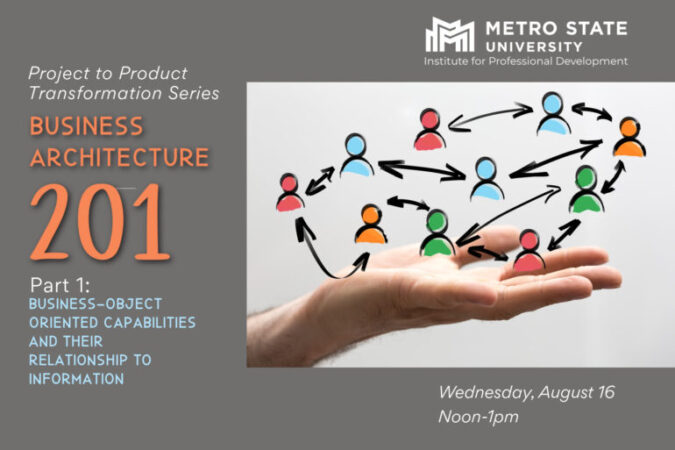
Business Architecture 201: Session 1
This session will focus on business capabilities and their role and position in the larger business architecture framework. It will explain how capabilities can be used as building blocks to achieve the outcomes an organization strives to define and execute and demonstrate how capabilities use and modify information with an example drawn from ongoing work to transform Minnesota’s human service delivery systems.
About the Series:
This series will explore the core business architecture domains that DHS is leveraging to integrate service delivery and develop an enterprise portfolio of products. The series will be especially helpful to the public sector and others whose product is a service, rather than a tangible item for purchase.
As the name 201 suggests, those with some background in business architecture or enterprise architecture may find the series more informative.
ABOUT THE PRESENTER:
Katherine (Kit) Shelton from the Department of Human Services (DHS) for the State of Minnesota is applying business architecture to help DHS transform service delivery by coordinating distributed work to integrate services and transition to a product operating model. She and two other Enterprise Business Architects in the Agency Effectiveness Administration lead a cross-functional team of business experts from all over the department to apply shared principles and common standards across business units to integrate multiple perspectives into a single enterprise-wide business framework.
Business Architecture 201: Part 2 – Using Architectural Value Streams to Center the People We Serve | Past Expert Insights Webinar
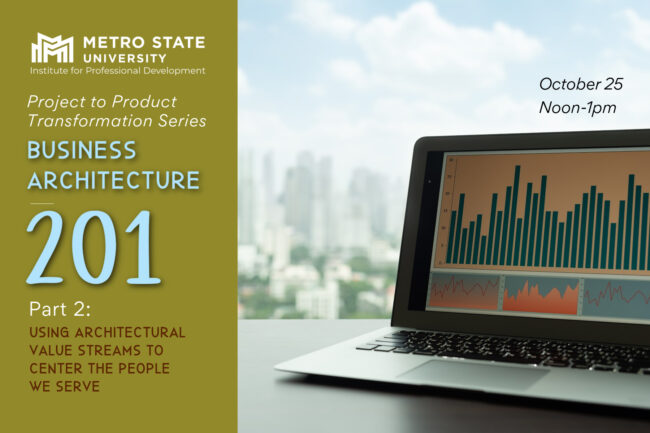
Business Architecture 201: Session 2:
As the name 201 suggests, those with some background in business architecture or enterprise architecture may find the series more informative.
This session will focus on value streams and demonstrate their role and position in the larger business architecture framework. The presenter will illustrate the conceptual structure of an architectural value stream with a real-life example drawn from work to transform Minnesota’s human service delivery system. Learn the relationship between an organization’s value propositions and the experience of the people who seek value from the organization.
About the Series:
This series will explore the core business architecture domains that DHS is leveraging to integrate service delivery and develop an enterprise portfolio of products. The series will be especially helpful to the public sector and others whose product is a service, rather than a tangible item for purchase.
ABOUT THE PRESENTER
Katherine (Kit) Shelton from the Department of Human Services (DHS) for the State of Minnesota is applying business architecture to help DHS transform service delivery by coordinating distributed work to integrate services and transition to a product operating model. She and two other Enterprise Business Architects in the Agency Effectiveness Administration lead a cross-functional team of business experts from all over the department to apply shared principles and common standards across business units to integrate multiple perspectives into a single enterprise-wide business framework.
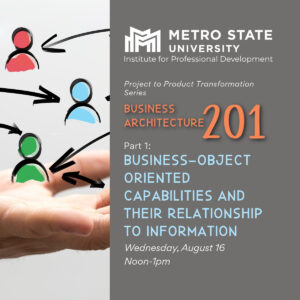 Interested in Watching the First Part of the Series?
Interested in Watching the First Part of the Series?
This video focuses on business capabilities, the role, and position in the larger business architecture framework.
Learn how capabilities can be used as building blocks and how to demonstrate how capabilities use and modify information.
The Modern Business Architect: Lessons from the Field: Part 1 – A Business Architect’s Role in Product Management | Past Expert Insights Webinar
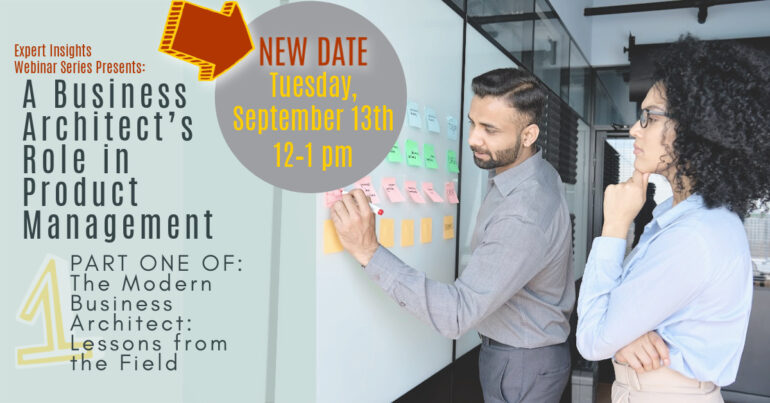
Expert Insights Webinar
A Business Architect’s Role in Product Management
This is Part One of a Three Part Series:
The Modern Business Architect: Lessons from the Field
Audience:
You do not need to be a business architect to find this series useful, others will also find benefits for themselves and their organizations
- Enterprise architects
- product owners
- project managers
- business analysts
Learn more about how product managers can use business architecture in their roles.
WATCH PART TWO:
Getting the Business to Care About Business Architecture
WATCH PART 3:
Modern Approaches to Collaborating Across Architecture Disciplines
ABOUT THE PRESENTER
Dean Heltemes
A Modern Business Architect working in the field and teaching for Metro State’s business architecture program.
Politics in the Office: Part 1

Many of us are familiar with office politics – advocating for power in the workplace.
Increasingly, the angst created by office politics is taking second place to angst generated by politics in the office.
The 2024 Presidential election is being touted as “high-stakes.” This sense of urgency makes it almost impossible to keep political discussions out of the workplace. And, with all that comes with high-stakes election rhetoric, it seems almost impossible to maintain a welcoming workplace culture that is inclusive to all points of view.
During my career, I have played many roles in workplace political discussions. Here are some roles I have tried out over the years.
The Observer
The Observer listens to what is being said, but remains silent. The Observer may (or may not) have a viewpoint, but attempts to appear neutral or mysterious on political views. Never weighing in has several advantages:
- You never reveal your ignorance of politics or your lack of attention to current events.
- You never reveal your apathy of politics and risk having someone tell you that you NEED to care and take a stand. It is your FUTURE!
- You never offend anyone because you have never said anything.
- You never get lectured by someone who follows you down the hall or catches you in the parking lot trying to convince you of how wrong you are about your beliefs or vote.
The Apathetic
The Apathetic does not care. And they are vocal about it so that all who work with them know that they find politics to be a waste of time. This allows them the freedom to disengage from any political discussion. While we may find it easy to make presumptions about The Apathetic, there could be several reasons for political apathy:
- Perhaps they do not feel that either side can fix anything.
- Perhaps they are embarrassed by the behavior of political leaders and wish to avoid association with any side.
- Perhaps they are young and free and having too much fun to worry about THE FUTURE.
- Perhaps, they are too busy working 2 jobs or caring for 3 children or caretaking parents or fighting a medical illness to take the time needed to truly study the issues for an informed opinion.
The Apathetic can present as The Observer IF they do not ever voice their apathy. Once you take a pronounced Apathetic stance, you will be immersed in workplace political discussions: See #4 from The Observer.

The Worker
The Worker has definite opinions on the state of the country and is current in their knowledge of the political landscape. The Worker may even agree with most of the political rhetoric being heard in the workplace. However, The Worker wants time spent at work to be about working. They want workplace harmony so that they can get things done. If and when progress is derailed, The Worker wants those challenges to be related to the work. I am often The Worker, and I use similar techniques to The Marginal (see below) to manage political conversations in the workplace. Because The Worker is head-down productive, the Worker might be mistaken for The Observer or The Apathetic.
The Marginal
The Marginal believes their opinion is the opposite of most of the people they work with. As our politics become more combative, more us vs them, more we’re right and you’re wrong, and more all or nothing, I can often find myself in the margins. Even if I want some of the same outcomes as the majority, the approach and rhetoric being used makes me uncomfortable. I do not want to nod my head in agreement nor do I want to find myself facilitating a political discussion. The Marginal role is difficult and uncomfortable; you can feel limited on options:
- Go along to get along. You pretend to agree with political platforms touted by others to avoid an argument, but you may feel like a fraud.
- Speak up. You can speak up and spark a discussion, but you risk isolation and see (again) #4 of The Observer about people following you to your car. And, do you risk promotion if you disagree with the wrong people?
- Divert. The weather is always a good option. This option, while a safe route, can make you feel shallow because it avoids important life topics- at least at work.
- Avoid. You take steps to avoid certain coworkers or even workplace gatherings and meetings to avoid having to navigate this political situation. This option can also limit your workplace productivity.

The Majority
The Majority believes that their opinion is the opinion of everyone in the office. As a young teacher, I firmly believed that those I worked with were on the left. This appeared to make workplace political discussions easy to navigate because I thought I could predict which statements would be acceptable and which statements would generate animosity. The environment felt safe because even if I never said a word, I could nod in agreement. As I spend more time in the workplace, I realize that I am probably never in the majority, but more likely, surrounded by:
- Observers
- Apathetics
- Workers
- Marginals
When in the role of The Majority, I was making a lot of assumptions about the people in my workplace. And, most likely, I was making many coworkers uncomfortable with my “I have all the answers” political statements.
Perhaps, you have also played (or play) these same roles. In reflecting on these roles, I realize that I do not think I have ever received any guidance for how to handle politics in the office. September’s article: Politics in the Office: Part 2 will provide some resources that we might all find helpful to navigate the workplace during this 2024 election season.



